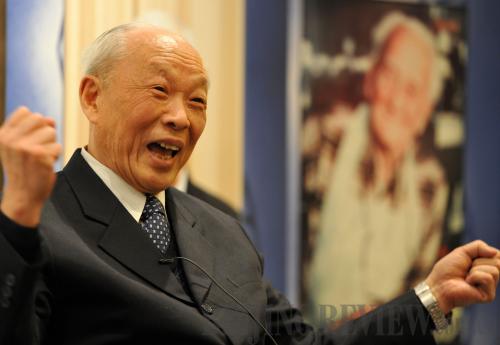|
 |
|
PRIZE RECIPIENT: Wang Zhenyi is a co-recipient of the Seventh Annual Szent-Györgyi Prize for Progress in Cancer Research in New York, the United States (WANG LEI) |
Accolades can come in many forms, but the recognition bestowed upon one Chinese scientist is truly out of this world.
Not long ago, the Minor Planet Center (MPC) based in the United States approved the designation of a minor planet—No. 43259, for those keeping count—with the name of Chinese scientist Wang Zhenyi.
Wang, born in 1924, is currently a tenured professor at the Medical School of Shanghai Jiao Tong University (SJTU), hematologist-academician of Chinese Academy of Engineering (CAE), and a veteran expert in blood cancer.
Wang developed creative clinical treatments for leukemia, in particular the treatment of acute promyelocytic leukemia (APL) using all-trans retinoic acid. For this achievement, he was awarded China's State Supreme Science and Technology Award in 2010.
Even at 88 years old, Wang is still energetic and dynamic. He adheres to the routine of going to his office in Ruijin Hospital at SJTU in Shanghai every morning to do medical research, diagnose and treat patients. Wang is so busy with his research work that he missed the award ceremony held by the Ministry of Science and Technology to receive the certificate of MPC designation in Beijing on June 4. Wang explained his absence by joking, "I don't want to go to 'heaven' so soon."
Fighting cancer
Wang and other Chinese hematologists had been working on developing an effective therapy for the fatal disease for over 20 years since 1959.
The type of leukemia Wang and his team worked on is among the disease's most serious forms. Though APL was a rare disease at the start of their research, it had a 100-percent mortality rate as there was no effective treatment at that time.
Essentially, APL is caused by pathological changes during the growth of white blood cells in the blood and marrow. White blood cells are vital for maintaining an immunologic balance in the human body. If white blood cells fail to grow normally they will destroy the body's defense system and cause the patient to eventually die from outside infections.
Traditionally, APL was treated with chemotherapy. This therapy is a double-edged sword because it can kill both bad and good blood cells, causing further damage to the immune system.
In 1959, Wang witnessed the disastrous failure of chemotherapy. In that year, there were a total of 60 leukemia patients from around the country receiving chemotherapy treatment at the Shanghai Second Medical University hospital. In less than half a year, the patients had died from the disease and ineffective therapy. "It was a huge blow to me because I was their physician-in-charge," Wang said.
The result aroused Wang's suspicion against chemotherapy. He began to think about a new way to cure blood cancer.
In early 1972, Israeli scientists had proven in animal experiments that cancer cells can be reverted into healthy cells.
Based on this evidence, Wang put forward a differentiation induction theory. With medicine, he said, the cancer cells can return to normal and stop spreading throughout the body.
"Unlike a virus, cancer cells derive from normal cells," Wang explained. "It is like a bad child in the family. Should the parents just beat it into submission or guide the right path for it? In the past, doctors used medicine to poison cancer cells but also damaged healthy cells. Differentiation induction therapy is a way to help cancer cells become healthy again," he continued.
Finding an effective induction medicine that can distinguish cancer cells from good cells proved to be a challenge.
In 1983, Wang found some good news in a U.S. medical journal that suggested the APL cancer cells can make a reversion change toward normal white blood cells under the effect of roaccutane isotretinoin. But in China, pharmaceutical producers could only make all-trans retinoic acid (ATRA). It was highly expensive to buy the former medicine from the United States, at $2,000 per treatment—a whopping price in the 1980s. Moreover, doubts remained as to the effectiveness of the treatment.
Wang had to find another way. Since both roaccutane isotretinoin and ATRA are geometric isomers of retinoic acid, he came up with the idea of using the latter for experiments.
After numerous failures and adjustments, Wang saw the dawning light of success a year later. The team of scientists produced solid results showing that ATRA can induct the differentiation of promyelocytic cells, turning the cancer cells into good ones.
Groundbreaking cure
One day in 1985, a 5-year-old girl Yan Yijun was sent to the Children's Hospital of Shanghai. The little girl was near death due to APL, suffering from a high fever and bleeding from her mouth and nose. Wang's wife, Xie Jingxiong, was a hematology expert in the hospital. Xie found it difficult to cure the girl, so she consulted with her husband about the disease.
| 